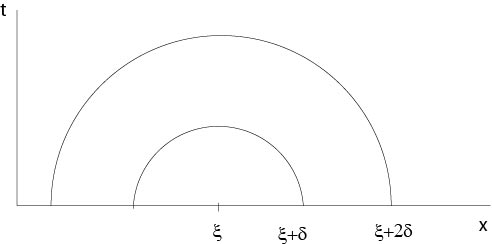6.1: Fórmula de Poisson
- Page ID
- 118023
Supongamos que\(u\) es una solución de (6.2), entonces, dado que la transformada de Fourier es un mapeo lineal,
\[\widehat{u_t-\triangle u}=\hat{0}.\]
De las propiedades de la transformada de Fourier, ver Proposición 5.1, tenemos
\[\widehat{\triangle u}=\sum_{k=1}^n\widehat{\frac{\partial^2 u}{\partial x_k^2}}=\sum_{k=1}^n i^2\xi^2_k\widehat{u}(\xi),\]
siempre que existan las transformaciones. Así llegamos a la ecuación diferencial ordinaria para la transformada de Fourier de\(u\)
\[\frac{d\widehat{u}}{dt}+|\xi|^2\widehat{u}=0,\]
donde\(\xi\) se considera como un parámetro. La solución es
\[\widehat{u}(\xi,t)=\widehat{\phi}(\xi)e^{-|\xi|^2 t}\]
ya que\(\widehat{u}(\xi,0)=\widehat{\phi}(\xi)\). Del Teorema 5.1 se sigue
\ begin {eqnarray*}
u (x, t) &=& (2\ pi) ^ {-n/2}\ int_ {\ mathbb {R} ^n}\\ sombrero ancho {\ phi} (\ xi) e^ {-|\ xi|^2t} e^ {i\ xi\ cdot x}\ d\ xi\
&=& (2\ pi) ^ {-^ -n}\ int_ {\ mathbb {R} ^n}\\ phi (y)\ izquierda (\ int_ {\ mathbb {R} ^n} e^ {i\ xi\ cdot (x-y) -|\ xi|^2t}\ d\ xi\ derecha)\ dy.
\ end {eqnarray*}
Set
$$K (x, y, t) = (2\ pi) ^ {-n}\ int_ {\ mathbb {R} ^n} e^ {i\ xi\ cdot (x-y) -|\ xi|^2t}\ d\ xi.\]
Por los mismos cálculos que en la prueba del Teorema 5.1, paso (vi), encontramos
\ begin {ecuación}
\ label {kernel1}
K (x, y, t) =( 4\ pi t) ^ {-n/2} e^ {-|x-y|^2/4t}.
\ end {ecuación}
\ (K (x, y, t)\),\(\rho=|x-y|\),\(t_1<t_2\) "height="213" width="403" src=” https://math.libretexts.org/@api/dek.../parabfig2.jpg "/>
Figura 6.1.1: Núcleo\(K(x,y,t)\),\(\rho=|x-y|\),\(t_1<t_2\)
Así tenemos
\ begin {ecuación}
\ label {poisson1}
u (x, t) =\ frac {1} {\ izquierda (2\ sqrt {\ pi t}\ derecha) ^n}\ int_ {\ mathbb {R} ^n}\ phi (z) e^ {-|x-z|^2/4t}\ dz.
\ end {ecuación}
Definición. La fórmula (\ ref {poisson1}) se llama fórmula de Poisson} y la función\(K\) definida por (\ ref {kernel1}) se llama núcleo de calor o solución fundamental de la ecuación de calor.
Proposición 6.1 El kernel\(K\) tiene las siguientes propiedades:
- i)\(K(x,y,t)\in C^\infty(\mathbb{R}^n\times\mathbb{R}^n\times\mathbb{R}^1_+)\),
- ii)\((\partial/\partial t\ -\triangle)K(x,y,t)=0,\ t>0\),
- iii)\(K(x,y,t)>0,\ t>0\),
- iv)\(\int_{\mathbb{R}^n}\ K(x,y,t)\ dy=1\) \(x\in\mathbb{R}^n\),\(t>0\)
- \(\delta>0\):( v) Por cada fijo
$$\ lim_ {\ begin {array} {l} t\ to0\ t>0\ end {array}}\ int_ {\ mathbb {R} ^n\ setmenos B_\ delta (x)}\ K (x, y, t)\ dy=0$$
uniformemente para\(x\in\mathbb{R}\).
Comprobante. (i) y (iii) son obviamente, y (ii) se desprende de la definición de\(K\). Las ecuaciones (iv) y (v) se mantienen desde
\ begin {eqnarray*}
\ int_ {\ mathbb {R} ^n\ setmenos B_\ delta (x)}\ K (x, y, t)\ dy&=&\ int_ {\ mathbb {R} ^n\ setmenos B_\ delta (x)}\ (4\ pi t) ^ {-n/2} e^ {-|x-y|2/4t}\ dy\\
&=&\ pi^ {-n/2}\ int_ {\ mathbb {R} ^n\ setmenos B_ {\ delta/\ sqrt {4t}} (0)} e^ {-|\ eta|^2}\ d\ eta
\ end { eqnarray*}
mediante el uso de la sustitución\(y=x+(4t)^{1/2}\eta\). Para fijo\(\delta>0\) sigue (v) y para\(\delta:=0\) obtenemos (iv).
\(\Box\)
Teorema 6.1. Asumir\(\phi\in C(\mathbb{R}^n)\) y\(\sup_{\mathbb{R}^n}|\phi(x)|<\infty\). Entonces\(u(x,t)\) dada por la fórmula de Poisson (\ ref {poisson1}) está en\(C^{\infty}(\mathbb{R}^n\times\mathbb{R}^1_+)\), continua\(\mathbb{R}^n\times[0,\infty)\) y una solución del problema de valor inicial (6.2), (6.3).
Comprobante. Queda por mostrar
$$
\ lim_ {\ begin {array} {l} x\ to\ xi\
t\ to0\ end {array}} u (x, t) =\ phi (\ xi).
\]

Figura 6.1.2: Figura a la prueba del Teorema 6.1
Ya que\(\phi\) es continuo existe para dado\(\varepsilon>0\) un\(\delta=\delta(\varepsilon)\) tal que\(|\phi(y)-\phi(\xi)|<\varepsilon\) si\(|y-\xi|<2\delta\).
Set\(M:=\sup_{\mathbb{R}^n}|\phi(y)|\). Entonces, ver Proposición 6.1,
$$
u (x, t) -\ phi (\ xi) =\ int_ {\ mathbb {R} ^n}\ K (x, y, t)\ izquierda (\ phi (y) -\ phi (\ xi)\ derecha)\ dy.
$$
Se deduce, si\(|x-\xi|<\delta\) y\(t>0\), que
\ begin {eqnarray*}
|u (x, t) -\ phi (\ xi) |&\ le&\ int_ {B_ {\ delta} (x)}\ K (x, y, t)\ izquierda|\ phi (y) -\ phi (\ xi)\ derecha|\ dy\
&&+\ int_ {\ mathbb {} ^n\ setmenos B_ {\ delta} (x)}\ K (x, y, t) \ izquierda|\ phi (y) -\ phi (\ xi)\ derecha|\ dy\
&\ le&\ int_ {B_ {2\ delta} (x)}\ K (x, y, t)\ izquierda|\ phi (y) -\ phi (\ xi)\ derecha|\ dy\
&&&+2M\ int_ {\ mathbb {R} ^n\ setmenos _ {\ delta} (x)}\ K (x, y, t)\ dy\\
&\ le&\ varepsilon\ int_ {\ mathbb {R} ^n}\ K (x, y, t)\ dy+2m\ int_ {\ mathbb {R} ^n\ setmenos B_ {\ delta} (x)}\ K (x, y, t)\ dy\\
&<&2\ varepsilon
\ end {eqnarray*}
si\(0<t\le t_0\),\(t_0\) suficientemente pequeño.
\(\Box\)
Observaciones. 1. La singularidad sigue bajo el supuesto de crecimiento adicional
$$
|u (x, t) |\ le Me^ {a|x|^2}\\\ mbox {in}\ D_T,
$$
donde\(M\) y\(a\) son constantes positivas,
vea la Proposición 6.2 a continuación.
En el caso unidimensional, uno tiene singularidad en la clase\(u(x,t)\ge 0\) en\(D_T\), ver [10], pp. 222.
2. \(u(x,t)\)definido por la fórmula de Poisson depende de todos los valores\(\phi(y)\),\(y\in\mathbb{R}^n\). Eso quiere decir, una perturbación de\(\phi\), incluso lejos de una fija\(x\), influye en el valor\(u(x,t)\). Esto significa que el calor viaja con una velocidad infinita, en contraste con la experiencia.


